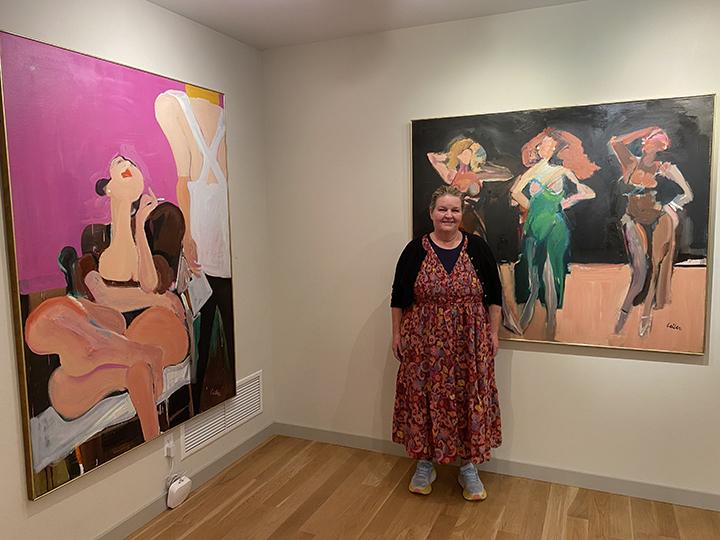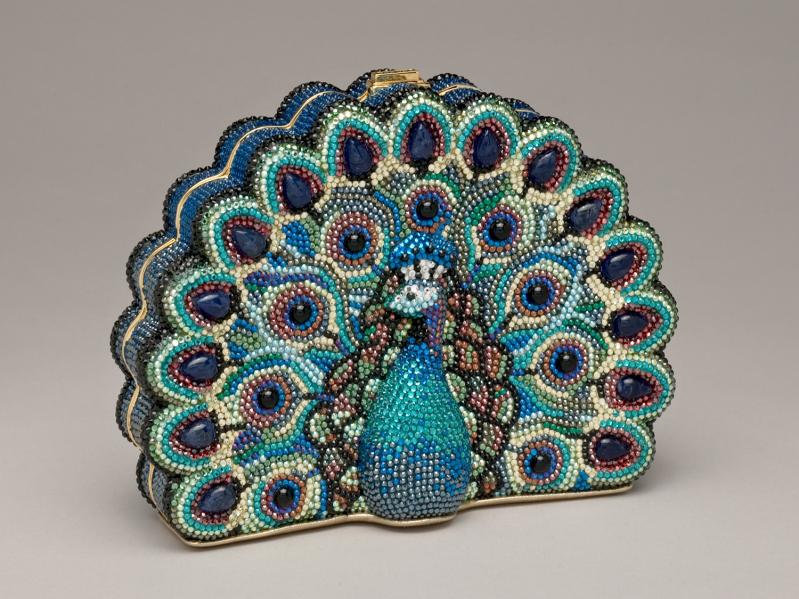It's easy to drive past the Leiber Collection on Old Stone Highway in Springs and never know it's there. Hidden from the road by trees, the imposing Renaissance-style Palladian building houses astounding handbags created by Judith Leiber and vibrant paintings by her husband, Gerson.
"Usually, before Covid, these doors would be closed," said Ann Fristoe Stewart, the collection's director and curator, as she prepared to open them for a visitor. "People would walk in and be blown away, because they don't expect to see this in Springs, and they don't expect it to be so beautiful."
The small entrance gallery displays a selection of Judith's iconic handbags and minaudieres. The high-ceilinged main gallery is lined with display cases of more handbags -— there are 1,700 in the collection -- and hung high above them are paintings from Gus's fashion series.
"Whenever Judy would release a new handbag line, Gus would have a new exhibition in the showrooms," said Ms. Stewart. "They really went hand in hand. Many of his fashion series are in the collections of fashion designers and buyers. It made sense to hang them here with the handbags." More of his fashion paintings are installed in a smaller rear gallery.

The exhibitions in the main and rear galleries change every year. Of the handbags, Ms. Stewart, who came to the collection in 2010, said it used to take almost a month to install each season's show. "It's amazing how just rotating something, or tilting it a tiny bit, will make or break the vignette. A lot of the fine-tuning takes a while."
The Leibers never wanted the works installed in alphabetical order, numerical order, or by color, and they avoided wall labels or other explanatory material, she said. "So I typically curate the way Gus would paint, leading your eye through with a color, or having the compositions be about line or grouping." The couple died with hours of each other in 2018; she was 97, he was 96.

What prepared Ms. Stewart to take over the directorship of such a singular institution? She grew up in Atlanta and moved to New York in 1990 to attend the Parsons School of Design. After earning a bachelor of fine arts in drawing and painting, she went to study in Italy and "fell madly in love with sculpture." She returned to Parsons for her M.F.A., this time in sculpture.
One of her teachers at Parsons was Rona Pondick, a sculptor whose work Ms. Stewart admired. She served as a studio assistant for Ms. Pondick, and traveled with her to Israel to work on a project for five weeks there.
"And then I started working for Jeff Koons."
Beginning as a studio assistant, she became the manager of Mr. Koons's operation, overseeing the work of 80 sculptors and 80 painters during the creation of the artist's "Celebration" series of 15 major sculptures. While there, she and her husband, Bill Stewart, an artist, decided they wanted to do the same kind of work for other artists, and started Sculpture City, an art fabrication company.
One of the artists they work with is Kara Walker, who creates her silhouettes by drawing the images with chalk, on a roll of black paper, and cutting them out with an X-Acto knife. Once the original has been shown, Ms. Walker sends the Stewarts the cutouts for the production of templates and exhibition copies. Mr. Stewart does the large-scale sculptural projects now, but Ms. Stewart still does most of Ms. Walker's work.
The Stewarts moved to Springs in 2003. They had fallen in love with the East End while visiting Jill Musnicki and Jameson Ellis, artists and friends of Mr. Stewart since college. After 9/11, anxious to leave the city, they bought a sailboat and traveled from Fort Lauderdale, Fla., to New York, and eventually to Three Mile Harbor.
Another friend provided the link to the Leiber Collection. Jess Frost had been the archivist and collection manager at the collection since 2004. When Ms. Frost was offered the directorship of the Glenn Horowitz Gallery in 2010, she asked Ms. Stewart to meet the Leibers.
"She told me not to be offended if they didn't like me, because they didn't like everyone," said Ms. Stewart. "But we ended up talking for hours, and they hired me."
Ms. Stewart immediately began organizing the exhibitions. "At first they would be here with me, and we would be doing the curating together. After we did the first one, they said, why are we doing this? So they gave me their blessing and let me curate after that."
The Leibers had an extensive collection of art, ranging from antique Chinese porcelains (140 of which comprised the first exhibition there in 2008) to works by friends, one of whom, Will Barnet, taught Gus at the Art Students League. A show of prints by Barnet and watercolors by Gus filled the gallery in 2009. Japanese woodblock prints from their collection followed a year later.
While there are now some Chinese porcelains in a small upstairs gallery, Ms. Stewart is not sure there will be larger shows from the Leibers' personal collection in the future. "People want to see Gus and Judy."
The building is situated in a garden that reflects Gus's obsession with shrubbery. Brick paths wind through a variety of specimen plants and gardening styles, with sculpture along the way by such artists as Bill King and Hans van de Bovenkamp, as well as a series of small garden nymphs created by Gus.
In 2020, because of Covid, the building was closed until well into the summer. Because the garden was able to open sooner, Ms. Stewart used it as the setting for the first exhibition of work by contemporary local artists. "The Garden of Friends" included pieces by Philippe Cheng, Peter Dayton, Warren Neidich, Toni Ross, Bastienne Schmidt, and Almond Zigmund.
"The Garden of Friends" has since become an annual show, this year featuring work by 24 artists. In addition, a January show of work by the artists in the summer 2022 iteration was held at Kathryn Markel Fine Arts in Bridgehampton.
Judith Leiber designed over 3,500 handbags, and a long-term goal is for the collection to have one of each. Because there is no catalog raisonne, "it's like finding a needle in a haystack, but it's really fun," said Ms. Stewart. Once found, the goal is to buy it or have it donated.
When one collector died recently, her children donated 100 of Judith's bags. They were displayed together for one season to honor the donor, then mixed in with the rest.
One missing bag Judith had wanted for years was the 1978 "Hollywood" minaudiere. On one visit to the Leibers, Kelly Ellman, who had a large collection of Leiber handbags, asked Judith which of her many bags she missed the most. Ten minutes after Ms. Ellman left, she called Ms. Stewart and told her she was going to give Judy the Hollywood bag. "All she asked for was a photograph of Judy when she opened the box."
For her first collection, launched in 1963, Judith used a greenish-gray color and a fine kidskin leather. The bags hit the shelves just after the Kennedy assassination, "when most people weren't thinking about handbags. But she said it was a huge flop, and that she would never again put her creative eggs in one basket."
Each subsequent line would include different skins, different fabrics, and whimsical imagery. Her last bag was a peacock-shaped minaudiere from 2004. She shifted her focus to the museum once it opened.
"I really adored Gus and Judy," said Ms. Stewart. "They were so brilliant, and they had so much deep cultural knowledge, about art, fashion, and history. I was really enamored of their life story and philosophies -- going through World War II and the Holocaust, and coming out of those really horrific life experiences with the desire to share beauty with the world. And also, their incredible devotion to each other was so powerful."




